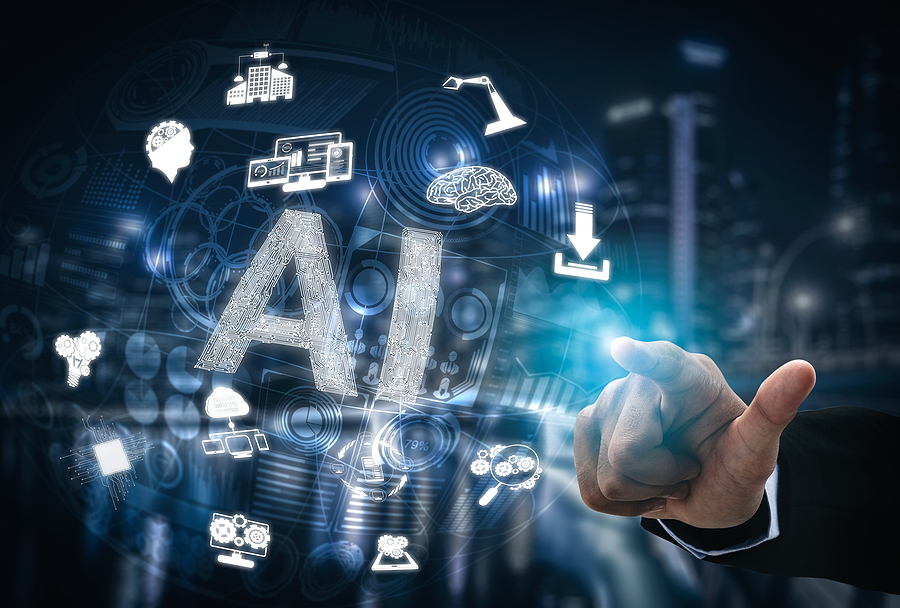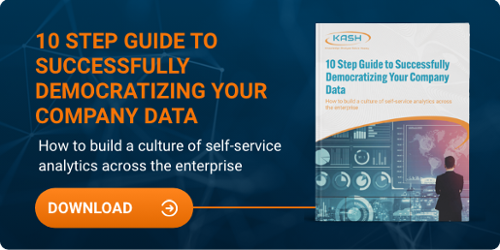How to Adopt AI and Machine Learning to Transform your Business Intelligence
Topic:
Democratizing Data
Integrating Artificial Intelligence (AI) and Machine Learning (ML) into your business intelligence requires more than just technology. It also depends on the people managing your BI and the processes you use. People, Processes, and Technology are the three foundational elements that must be in place to leverage your data.
As such, successful implementation requires you to have team members in place with an aptitude for AI and ML. Your team must be able to create and guide processes to comply with data governance standards and manage your technology platform to support the automated processing of big data to provide actionable insights.
What Is Business Machine Learning?
Machine learning in business intelligence includes the technologies and algorithms that enable systems to identify patterns from data, turning the raw data into insights. One big advantage of machine learning is that once models are trained, they can be taught to find patterns and anomalies that may not be obvious. In other words, they can uncover hidden correlations that might otherwise go unknown.
What Is the Difference Between AI and Machine Learning?
While often used interchangeably, there’s a key difference. AI refers to the development of computer systems that can emulate human thoughts and perform tasks that normally require human intervention to support decision-making. ML can make decisions, including improving itself with experience.
They do go hand-in-hand as machine learning paves the way for AI and the modernization of data for advanced business intelligence.
How Do Machine Learning and AI Help Businesses?
Organizations today are amassing astounding amounts of data. The proliferation of IoT and IIoT devices, along with the rollout of 5G is only adding to these mass data stores. The majority of the data is unstructured, which adds to the challenge of leveraging data.
Yet, AI and ML can take all of this raw data and, once models are trained, be fundamental to true digital transformation. As a result, business users can understand and perform actions on data-driven insights faster and with greater efficiency.
AI/ML provides businesses with significant advantages, including:
- Automating manual processes that support decision-making based on data.
- Allows faster decision-making at scale to increase speed.
- Generate insights that produce better product development or business expansion.
- Improving customer experiences.
- More accurate prediction and forecasting capabilities.
- Reducing or eliminating human error.
How to Successfully Implement AI/ML
Successfully implementing an AI/ML strategy requires businesses to take a holistic framework.
It’s not just the technology that will produce the value. Broad adoption requires buy-in from multiple stakeholders across the organization. Team members must trust the models and top executives must embrace the cultural shift to AI/ML.
A good place to start in implementing artificial intelligence and machine language strategies is to identify the best use cases. After identifying your use cases, you can then determine the data that’s required, who will use it, and what technology will support it best. Your technology platform must support the automated processing of data at scale and the dissemination of actionable information and insights.
To implement AI/ML in data analytics, businesses sometimes farm the data out to data scientists instead of creating a holistic data strategy across the enterprise. When this happens, you are minimizing the value of the data and creating data silos. This keeps the data’s power in the hands of a small group that may not have the ultimate decision-making authority. The right tech platform can lead to data democracy, so the data can be used by frontline employees to produce deep insights.
In today’s rapid-fire business environment, data scientists and analysts may not have the time to handle all of the data requests that come their way. By making data more available to other team members, using today’s no code/low code tools, you can dramatically increase adoption and broaden the impact of your business intelligence.
Examples of Artificial Intelligence & Machine Learning in Different Industries
 AI/ML in Manufacturing Use Cases
AI/ML in Manufacturing Use Cases
Operational efficiency is critical to gaining and maintaining a competitive advantage in manufacturing.
AI/ML can automate their business processes to:
- Provide earlier notification of pending equipment trouble before malfunctions occur, reducing scrap and error rates.
- Monitor equipment to predict when proactive maintenance should be performed, thus reducing downtime in production and improving worker safety.
- Detect patterns in customer behavior for more accurate demand forecasting.
- Improve supply chain management, including automatic reordering accounting for real-time supply chain conditions.
- Identify and suggest opportunities to streamline operations and inefficiencies.
AI/ML in Healthcare Use Cases
Healthcare providers rely heavily on analytics to provide and recommend health services to patients.
AI and ML are being used to:
- Analyze data from electronic health record (EHR) systems to augment clinical decision-making.
- Predict outcomes after hospital visits to prevent readmissions.
- Identify patients’ unique features from clinical phenotypes to arrive at precision medicine and custom therapeutic solutions.
- Automate administrative tasks such as pre-authorization of insurance, record maintenance, and following up on unpaid bills for those most at risk for nonpayment.
- Monitor patients using wearables and other devices to detect variations from baseline results to identify triggering events and prevent exacerbations.
AI/ML in Finance & Insurance Use Cases
AI and ML have spawned numerous FinTech companies and have replaced manual tasks in multiple processes for finance.
Examples include:
- Employ algorithmic trading, which now accounts for 60% to 70% of all financial market volume.
- Analyze consumer and commercial loan applications to speed up processing time from hours to seconds.
- Predict life stages and life events for more accurate underwriting for insurers.
- Identify fraud by analyzing hundreds of thousands of transactions and recognizing anomalies.
- Reduce risk by analyzing consumer sentiment about products and companies.
AI/ML in Marketing Use Cases
AI/ML allows marketers to create detailed and highly-personalized campaigns to improve how businesses recruit, nurture, and convert prospects.
AI and ML are being used to:
- Identify customer behavior across multiple channels and touchpoints to deliver personalized, relevant marketing messages at each stage of the buyer’s journey.
- Run automated A/B and multivariate testing to refine marketing messages for optimal effectiveness.
- Monitor consumer trends to identify changes, resulting in more efficient marketing based on current customer needs.
- Dynamically adjust content and advertising messages based on past interactions that result in the highest chance of success.
- Empower Chatbots with natural language processing and human-like conversational AI to reduce workloads for contact centers.
Conclusion
AI and ML can improve and enhance your organization's analytics for making more timely, informed, and accurate decisions.
However, successfully deploying artificial intelligence and machine learning requires more than just adding business intelligence tools to leverage AI and ML. It takes a holistic strategy that includes the people, processes, and technology working together. When done successfully, AI and ML can produce insights that might otherwise never be uncovered, speed up processes, and create new solutions to problems.
To learn how your organization can build a strategy and roadmap that addresses all aspects required to realize the value and desired business outcomes AI/ML can offer, download the eBook, "10 Step Guide to Successfully Democratizing Your Company Data."
